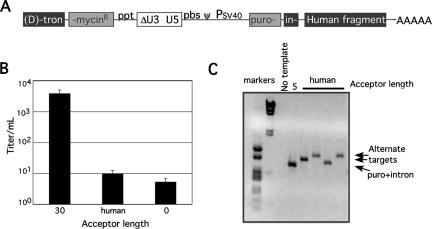FIG. 4.
Forced nonhomologous recombination. (A) RIO template containing a human sequence nonhomologous acceptor. The acceptor region included a 590-base fragment of human chromosome 14 that contains no region of identity greater than 3 bases with the 5′ end of the donor. Note that polyadenylation signal readthrough resulted in the appendage of RNA copies of plasmid backbone sequences to a subset of the vector RNAs' 3′ ends. Acceptor region abbreviations are given in the legend to Fig. 1. (B) Vector titers determined as described in Materials and Methods. 30 represents titers for the 30TM vector; human indicates humanTM values; 0 indicates the value for 0TM vector. (C) PCR amplification of cell DNA from individual puromycin resistance cell clones. The amplification product of a correctly targeted clonal 5-base acceptor product is shown, as are PCR products from representative individual humanTM product cell clones. The leftmost two lanes contain radiolabeled size standards. puro, puromycin.

